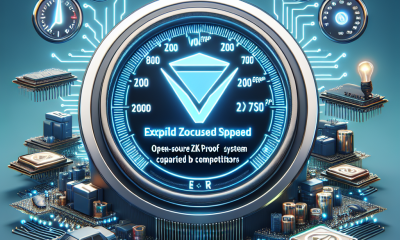Ethereum
Ethereum’s Vitalik Buterin and Crypto Influencer Ansem Engage in a Heated Exchange Over Ethereum and Celebrity Token Endorsements

The crypto community witnessed a clash of titans as Ansem, a notable crypto influencer, stirred a digital storm, catching the eye of ethereum‘s co-creator, Vitalik Buterin. The exchange between the two ignited a broader dialogue regarding the Ethereum blockchain’s performance relative to its competitors, specifically solana, marking a significant moment in the ongoing debate over blockchain efficiency and utility.
Ansem, known for his influential presence in the crypto world, recently found himself at the center of controversy following a series of posts on X (previously known as Twitter). The posts drew attention due to the downturn of the Davido token, which saw a dramatic fall of over 90.5% shortly after its launch, a debacle that was further aggravated by Caitlyn Jenner’s withdrawal of support and criticism from Buterin himself.
The backlash was swift, with many users pointing fingers at Ansem for promoting the token, thereby highlighting the risky nature of celebrity endorsements in the volatile crypto market. In response to the criticism, Ansem expressed regret over the Davido token fiasco, acknowledging his role in the event while emphasizing his commitment to rectifying the issue. He suggested that conversations were underway with teams about token-locking mechanisms and fostering long-term engagement within the crypto ecosystem beyond mere celebrity endorsements.
The crypto community’s response was mixed, with some users demanding more accountable actions over mere apologies. A user identified as TheFlowHorse exemplified this sentiment, arguing that it would be preferable for Ansem to outright admit his mistakes, bypassing what was perceived as evasive maneuvers.
The debate took an interesting turn when Vitalik Buterin, Ethereum’s co-founder, engaged with Ansem’s posts. Buterin’s involvement underscored the heated discussions in crypto circles, particularly focusing on the rivalry between Ethereum and other blockchains like Solana. Ethereum advocates, buoyed by the approval of a spot Ethereum ETF in the United States, defended the platform as the superior smart contract network, asserting its dominance and long-term viability against competing systems.
As the dust settles on this debate, the core issues at play transcend the individual spats between high-profile crypto figures. It showcases the complexities of the crypto market, where the confluence of technology, celebrity influence, and investor sentiment can create unpredictable outcomes. For Ethereum and its proponents, the incident has spurred introspection and dialogue about its place in the rapidly evolving blockchain ecosystem, reinforcing the vitality of innovation, transparency, and community engagement in maintaining and enhancing the platform’s standing in the competitive digital assets space.
The incident with Ansem and the wider exchange within the crypto community exemplifies the ongoing struggles within the crypto market to balance hype with substance, celebrity endorsements with genuine utility, and short-term gains with long-term viability. As the blockchain and cryptocurrency sector continues to mature, incidents like these offer crucial lessons on the importance of due diligence, the potential pitfalls of market speculation, and the enduring value of foundational technologies like Ethereum that continue to shape the future of digital finance.
Bitcoin
Ethereum Price Soars to $3,500 as SEC Concludes Probe, Marking a Victory for the Crypto Giant

In an unexpected turn of events, the cryptocurrency ecosystem witnessed a momentous increase in ethereum‘s value, surpassing the $3,550 mark. This spike came on the heels of the United States Securities and Exchange Commission (SEC) concluding a protracted investigation, that had cast a shadow over the digital asset’s status.
For quite some time, the cloud of uncertainty regarding whether Ethereum could be classified as an unregistered security loomed large. Investors’ unease over this potential classification contributed to a degree of market instability for Ethereum. The resolution of this probe, however, has seemingly quelled these fears, ushering in a wave of renewed confidence among investors and contributing to a notable uplift in Ethereum’s market valuation.
The crux of the SEC’s inquiry centered on the Ethereum Foundation, particularly scrutinizing the foundation’s dealings to determine if Ethereum warranted regulation under security laws—a situation that could have drastically dampened demand for the cryptocurrency. In a bold countermove, Consensys, a prominent player within the Ethereum ecosystem, filed a lawsuit on April 25, 2024. The lawsuit aimed to challenge the SEC’s authority over Ethereum, positing that it should be classified as a commodity, thereby exempting it from the stringent regulations applied to securities.
This legal confrontation marked a pivotal moment, rallying considerable support from the public and political figures alike. By June 7, a strong appeal had been made to the SEC, urging a reevaluation of their stance towards Ethereum. This advocacy bore fruit when, on June 18, the SEC’s Enforcement Division disclosed their decision to close their investigation into Ethereum 2.0, indicating they would not be pursuing enforcement action against Consensys. This announcement was warmly received by the market, with Ethereum’s trading value witnessing an uptick to $3,563, underscoring the market’s sensitivity to regulatory developments.
Despite this favorable outcome, Consensys continues to advocate for clearer regulations that nurture rather than stifle innovation. Their stance underscores a broader push within the cryptocurrency community for regulatory frameworks that recognize the unique dynamics of digital currencies and decentralized platforms. Such frameworks, proponents argue, are critical not just for protecting investor interests but also for ensuring the continued technological advancement of the sector without undue burdens.
The SEC’s decision not to pursue enforcement against Ethereum or Consensys has breathed new life into the debate around the classification of digital assets. While bitcoin enjoys widespread recognition as a commodity, the stance of the SEC suggests a more cautious approach towards most other cryptocurrencies, which it considers unregistered securities.
This episode highlights the ongoing challenges and complexities of regulating the fast-evolving cryptocurrency market. It also underscores the tension between fostering innovation within this burgeoning sector and ensuring adequate protections are in place. As the landscape continues to evolve, the calls for clear, coherent, and conducive regulatory frameworks grow louder. Stakeholders across the spectrum, from investors to innovators, are keenly watching the developments, hopeful for policies that balance regulatory oversight with the freedom to innovate.
In sum, the closure of the SEC’s investigation into Ethereum is a significant milestone for the cryptocurrency community. It not only reaffirms Ethereum’s standing within the legal and regulatory framework but also sets a precedent for how similar cases might be approached in the future. As the dust settles, the focus now shifts to how regulatory bodies worldwide will navigate the complex interplay of innovation and investor protection in the decentralized digital asset space.
Bitcoin
Cardano Community to Govern $681 Million Treasury Amidst Historic Chang Fork Upgrade

The Cardano community stands at the brink of a new era with the impending Chang Fork, transitioning into what is being hailed as the “Age of Voltaire.” This crucial step will thrust upon its members governance over an impressive treasury amassing over $683 million, elevating its status to possess the eighth-largest treasury within the cryptocurrency sphere. The accumulation of these funds, sourced from transaction fees and block rewards, earmarks a significant shift towards self-sustainability and fosters further development within the Cardano ecosystem.
In stark contrast to its contemporaries, Cardano’s treasury is unique, consisting solely of ADA tokens. This sets it apart from the norm observed in other blockchain protocols that diversify their treasury assets across stablecoins and notable cryptocurrencies such as bitcoin and ethereum. This strategic decision reflects Cardano’s commitment to its native token and the vision of its future.
The Cardano project, underpinned by a strategic roadmap, operates through a tripartite governance structure which includes the Cardano Foundation, Input Output Global (IOG), and EMURGO. These entities synergize efforts in development, research, and commercial activities, laying the groundwork for the treasury’s management. The proposed Chang Fork, a significant upgrade, will catalyze the shift towards a decentralized model for the blockchain ecosystem, marking it as an unprecedented milestone in Cardano’s journey and the broader industry.
Charles Hoskinson, the founder of Cardano, encapsulated the significance of this transition, envisioning a decentralized civilization that spans across the globe, powered by a complex governance system. Supported by an annual budget and the collective wisdom of the Cardano community, this evolution promises to introduce a highly advanced framework for blockchain governance. Hoskinson’s ambitions for Cardano extend far beyond technological innovation, fostering a global community bound by shared goals and collective decision-making processes.
The Chang Fork represents the culmination of a long-term vision for Cardano, transitioning control over to its community. This evolution will activate voting and treasury systems, enabling ADA holders to propose and pass resolutions on significant improvements and innovations. By empowering its network participants through an inclusive governance model via staking and delegation, Cardano embarks on achieving a significant degree of self-sustainability. This process not only democratizes innovation within the ecosystem but also ensures that the development trajectory aligns with the community’s aspirations.
Cardano’s roadmap and the Chang Fork initiative highlight the project’s commitment to a decentralized and inclusive model. With a focus on empowering its community members and fostering ecosystem development, Cardano is poised to set new standards in blockchain governance and operational sustainability. As it transitions into the Age of Voltaire, Cardano’s vision of a decentralized civilization seems increasingly attainable, promising a new chapter in the cryptocurrency domain marked by innovation, engagement, and collective progress.
Bitcoin
Revolution in Investment: Real-World Asset Tokenization Sector Surges Ahead of Ethereum and Bitcoin

In a remarkable surge within the cryptocurrency sector, the tokenization of real-world assets (RWA) has prominently emerged as the leader, eclipsing the performance of giants such as ethereum (eth) and bitcoin (btc). This ascendancy is powered by high-profile asset tokenizations and a positive regulatory landscape, showcasing the sector’s burgeoning potential and growing significance in the financial industry.
The sector’s remarkable performance is partly attributable to significant strides in high-profile use cases and regulatory advancements. For instance, on June 4, Galaxy Digital executed a multimillion-dollar loan secured by a 316-year-old Stradivarius violin, using its digital representation as a non-fungible token (NFT) for collateral. This innovative use case not only ensured strong security for Galaxy Digital but also illustrated the flexibility and potential of asset management through tokenization. The physical violin, secured and monitored under strict conditions in Hong Kong, demonstrates a tangible bridge between traditional assets and digital futures.
On the same note, Watford Football Club ventured into digital equity, offering approximately 11% of its shares in collaboration with digital investment platforms Republic and Seedrs. Such initiatives not only bring traditional assets into the digital ecosystem but also open new avenues for investment and ownership democratization.
Regulatory developments have also shown support for the burgeoning sector. A pivotal hearing titled “Next Generation Infrastructure: How Tokenization of Real-World Assets Will Facilitate Efficient Markets” was held on June 7 by the US Financial Services Committee. This forum brought together a diverse group of industry leaders and experts, ranging from Carlos Domingo, Co-founder and CEO of Securitize, to representatives from the financial markets sector and academia. Their discussions underscored the ongoing debate surrounding blockchain technology’s integration into traditional finance, indicating a move towards regulatory clarity and broader adoption of tokenization technologies.
The sentiment within the sector remains optimistic for the long-term. Prominent figures like BlackRock CEO Larry Fink have voiced their confidence in tokenization, emphasizing its potential to revolutionize investment strategies through instantaneous bond and stock settlements, thus significantly reducing settlement costs. Similarly, Jenny Johnson, CEO of Franklin Templeton, pointed out the transformative capability of RWA tokenization, from offering NFT-based Rihanna royalties to integrating loyalty programs with tangible assets. This perspective aligns with Johnson’s view on leveraging technology to merge traditional assets with blockchain, enhancing accessibility for younger investors and promoting a culture of saving and investment through digital wallets.
The embracing of RWA tokenization by traditional financial institutions is seen as a pivotal movement towards democratizing investment opportunities and fostering financial inclusion. Johnson’s insights highlight how reduced entry points and operational costs associated with tokenized assets could encourage more inclusive savings and investment practices, particularly among younger demographics. As traditional and digital financial realms converge, RWA tokenization stands as a beacon for the future of finance, weaving together technological innovation with the fabric of conventional asset management to pave the way for a more accessible and efficient financial ecosystem.
In essence, the rise of RWA tokenization not only exemplifies the dynamic and evolving nature of the cryptocurrency sector but also signals a broader trend towards integrating blockchain technology into mainstream financial practices. This integration promises to revolutionize asset management and investment, offering a more inclusive, efficient, and secure platform for investors and stakeholders across the globe.
-

 Cryptocurrency2 months ago
Cryptocurrency2 months agoExploring the Future of Finance: Regulated Settlement Network PoC Aims to Unify Banking and Securities on a Single Platform
-

 Cryptocurrency4 weeks ago
Cryptocurrency4 weeks agoFantom Foundation Boosts Blockchain Performance with Opera Upgrade to Hit 2000 TPS, Following Google Cloud Partnership
-

 Cryptocurrency2 months ago
Cryptocurrency2 months agoProtocol Village Announces ‘Expander’: An Open-Source ZK Proof System Doubling Speed Compared to Competitors
-

 Cryptocurrency1 month ago
Cryptocurrency1 month agoOpenAI Gears Up for Exciting ChatGPT Update: New Features and Potential Pricing Changes on the Horizon
-

 Altcoins1 month ago
Altcoins1 month agoFive Altcoins Including Pepe Coin and FLOKI Eye Major Gains: A Path to Turn $10,000 into $1 Million Revealed
-

 Cryptocurrency2 months ago
Cryptocurrency2 months agoDr. Ted Kaouk Named Inaugural Chief AI Officer by CFTC
-

 Memecoins2 months ago
Memecoins2 months agoTop Cryptocurrencies Poised for Growth in 2024
-

 Cryptocurrency2 months ago
Cryptocurrency2 months agoDropbox Suffers Significant Data Breach: A Detailed Look at the Incident



